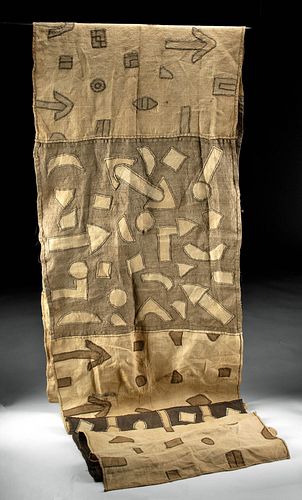Mid 20th C. African Kuba Cloth with Appliques
Lot 147
About Seller
Artemis Gallery
686 S Taylor Ave, Ste 106
Louisville, CO 80027
United States
Selling antiquities, ancient and ethnographic art online since 1993, Artemis Gallery specializes in Classical Antiquities (Egyptian, Greek, Roman, Near Eastern), Asian, Pre-Columbian, African / Tribal / Oceanographic art. Our extensive inventory includes pottery, stone, metal, wood, glass and textil...Read more
Categories
Estimate:
$4,000 - $6,000
Absentee vs Live bid
Two ways to bid:
- Leave a max absentee bid and the platform will bid on your behalf up to your maximum bid during the live auction.
- Bid live during the auction and your bids will be submitted real-time to the auctioneer.
Bid Increments
| Price | Bid Increment |
|---|---|
| $0 | $25 |
| $300 | $50 |
| $1,000 | $100 |
| $2,000 | $250 |
| $5,000 | $500 |
| $10,000 | $1,000 |
| $20,000 | $2,500 |
| $50,000 | $5,000 |
| $100,000 | $10,000 |
| $200,000 | $20,000 |
About Auction
By Artemis Gallery
Oct 8, 2020
Set Reminder
2020-10-08 10:00:00
2020-10-08 10:00:00
America/New_York
Bidsquare
Bidsquare : Exceptional Antiquities, Asian, Ethnographic
https://www.bidsquare.com/auctions/artemis-gallery/exceptional-antiquities-asian-ethnographic-5796
Museum-worthy examples of Egyptian, Greek, Roman, Etruscan, Near Eastern, Far East / Asian, Pre-Columbian, African / Tribal,Oceanic, Native American, Spanish Colonial, Russian, Fossils, Ancient Jewelry, Fine Art, so much more! Artemis Gallery info@artemisgallery.com
Museum-worthy examples of Egyptian, Greek, Roman, Etruscan, Near Eastern, Far East / Asian, Pre-Columbian, African / Tribal,Oceanic, Native American, Spanish Colonial, Russian, Fossils, Ancient Jewelry, Fine Art, so much more! Artemis Gallery info@artemisgallery.com
- Lot Description
Central Africa, Democratic Republic of the Congo, Kuba, ca. mid 20th century CE. An extremely long Kuba cloth comprised of seven rectangular panels of alternating cocoa brown and beige hues, each one presenting bold stylized geometric appliques such as arrows, double-headed arrows, orbs, squares, crescents, ovals, and more. The appliques on the beige ground are brown, while those on the brown ground are beige. Each applique is stitched with thread of the contrasting hue. Such abstract geometric patterns are usually symbolic of an individual's social and marital status, age, and/or personal attributes or character. Size: 180" L x 30" H (457.2 cm x 76.2 cm)
Traditionally, kuba cloth is woven from raffia-tree leaves; this example is comprised of naturally colored fibers created via a laborious process of hand-dyeing using mud, indigo, or the powdered bark of the camwood tree. Such cloths are usually created by Kuba men on a single heddle loom. Next they are embroidered by women and children to create an uncut or cut-pile appearance. Kuba cloths are worn during ceremonial events; however, they are also found in tapestries and home furnishings.
Provenance: private Los Angeles, California, USA collection, 1980s to 2000s
All items legal to buy/sell under U.S. Statute covering cultural patrimony Code 2600, CHAPTER 14, and are guaranteed to be as described or your money back.
A Certificate of Authenticity will accompany all winning bids.
We ship worldwide and handle all shipping in-house for your convenience.
#159561Some staining to panels, minor areas of loosened threads/fibers, and seam between two panels has separated a bit, but otherwise very good.Condition
- Shipping Info
-
All shipping is handled in-house for your convenience. Your invoice from Artemis Gallery will include shipping calculation instructions. If in doubt, please inquire BEFORE bidding for estimated shipping costs for individual items.
-
- Buyer's Premium



 EUR
EUR CAD
CAD AUD
AUD GBP
GBP MXN
MXN HKD
HKD CNY
CNY MYR
MYR SEK
SEK SGD
SGD CHF
CHF THB
THB















